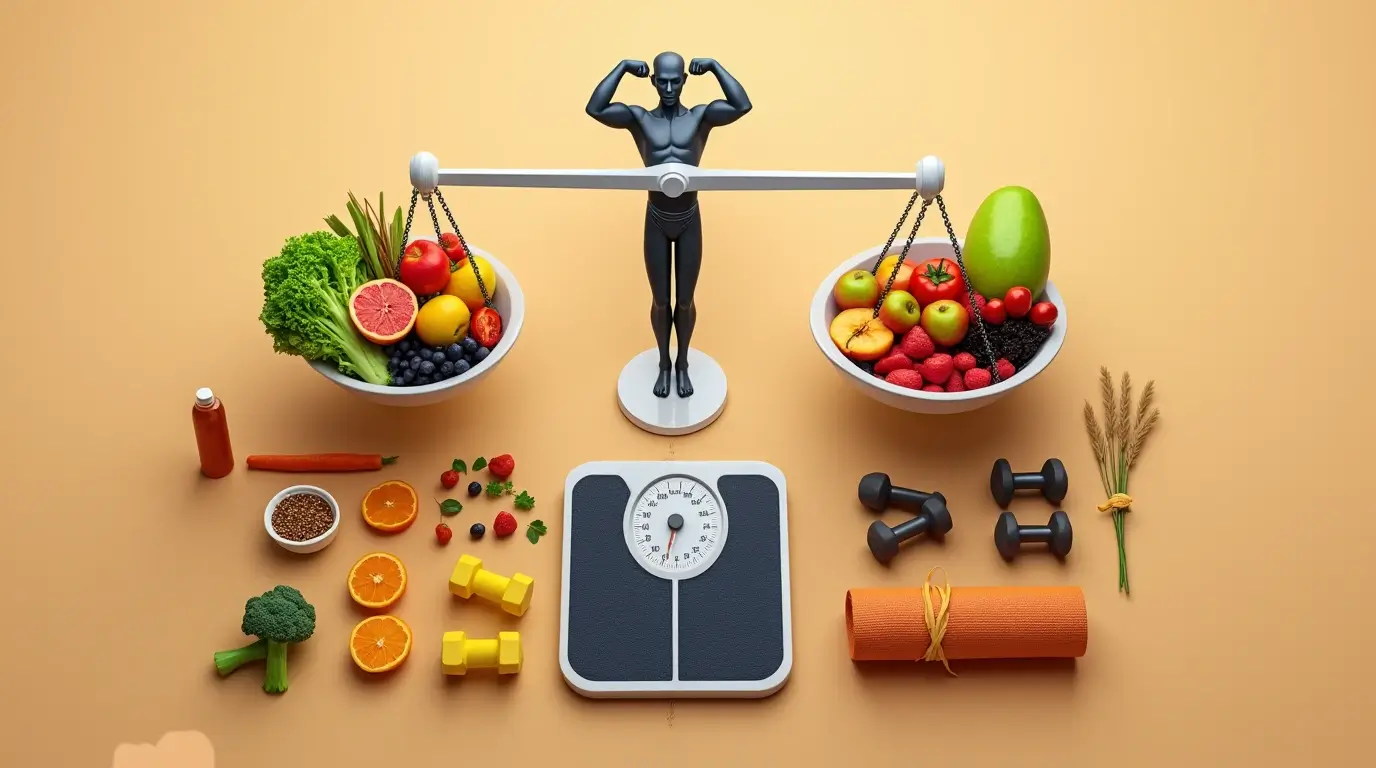Why Weight Control is More Than Just a Number on the Scale
You’ve probably heard it countless times: “It’s not about the number on the scale.” But let’s be honest, that number can be a source of frustration. If you’re reading this, it’s likely because you’ve experienced the struggle of trying to control your weight, whether you’re looking to lose a few pounds, maintain a healthy weight, or simply feel more comfortable in your body. The good news? Effective weight control isn’t a one-size-fits-all formula. In fact, it’s far more nuanced than just cutting calories or going on a fad diet.
Controlling your weight involves more than tracking the scale; it’s about balancing the intricate relationships between what you eat, how much you move, your lifestyle habits, and even your mental and emotional well-being. The right approach doesn’t just help you look better—it helps you feel better, both inside and out.
In this guide, you’ll learn the most effective strategies for controlling your weight in a sustainable and healthy way. From understanding your body’s energy balance to adjusting your lifestyle, you’ll discover actionable tips and insights that will put you on the path to long-term weight management success.
Table of Contents
Understanding the Basics of Weight Control
Before diving into the strategies, it’s essential to understand what weight control really involves. Simply put, weight control is about maintaining a healthy balance between the number of calories you consume and the number of calories your body uses. When these two factors are in balance, your weight stays stable. However, if you consume more calories than you burn, your body stores the excess as fat, leading to weight gain. Conversely, if you burn more calories than you consume, your body uses stored fat for energy, leading to weight loss.
Key Concepts to Understand:
- Energy Balance: This is the fundamental concept of weight control. To maintain or lose weight, you need to create a balance between the calories you eat and the calories you burn. Your goal should be to manage this balance in a way that aligns with your weight goals.
- Basal Metabolic Rate (BMR): BMR represents the number of calories your body needs to perform basic functions like breathing, digesting food, and maintaining body temperature. It’s important to understand your BMR as it helps determine how many calories your body needs on a daily basis.
- Thermic Effect of Food (TEF): Did you know that your body burns calories just by digesting food? This process is called the thermic effect of food, and it’s a natural part of digestion. Different foods require different amounts of energy to be processed.
By getting a better grasp of these concepts, you can more effectively manage your weight control efforts.
Comprehensive Strategies for Effective Weight Management
Achieving weight control isn’t about sticking to an overly restrictive diet or exercising until you’re exhausted. Instead, it’s about adopting a balanced approach that aligns with your lifestyle and preferences. Here are some key strategies to incorporate into your weight management plan:

1. Dietary Adjustments: Fueling Your Body Right
Your diet plays a crucial role in weight control. However, it’s not just about cutting calories—it’s about choosing the right foods that nourish your body while supporting your weight goals.
What Should You Eat?
- Proteins: Include lean sources of protein such as chicken, turkey, fish, eggs, tofu, and legumes. Protein helps to build and repair muscle tissue, and it also keeps you feeling full longer, which can prevent overeating.
- Healthy Fats: Opt for healthy fats found in foods like avocados, nuts, seeds, and olive oil. These fats provide essential nutrients and help keep your body functioning optimally.
- Complex Carbohydrates: Replace refined carbs with whole grains such as quinoa, brown rice, oats, and sweet potatoes. These complex carbs are packed with fiber, which can improve digestion and help you feel satisfied for longer periods of time.
- Fruits and Vegetables: Aim to fill half your plate with colorful fruits and vegetables. These foods are low in calories but high in nutrients, offering a variety of vitamins, minerals, and fiber that promote overall health.
Meal Planning and Portion Control:
- Plan Ahead: Take time to plan your meals in advance to ensure you are eating balanced meals throughout the day. This will prevent impulsive food choices and help you stay on track with your goals.
- Mind Your Portions: Eating healthy isn’t just about what you eat; it’s also about how much you eat. Use smaller plates to naturally control portion sizes, and try listening to your body’s hunger cues instead of eating out of habit.
Table: Recommended Daily Calorie Intake
| Age Group | Calories for Weight Maintenance | Calories for Weight Loss |
|---|---|---|
| 18-25 (Female) | 2,000-2,400 | 1,500-1,800 |
| 18-25 (Male) | 2,400-2,800 | 1,800-2,200 |
| 26-45 (Female) | 1,800-2,200 | 1,400-1,700 |
| 26-45 (Male) | 2,200-2,600 | 1,700-2,100 |
| 46+ (Female) | 1,800-2,200 | 1,400-1,700 |
| 46+ (Male) | 2,200-2,400 | 1,700-2,000 |
2. Exercise: Building a Stronger Body
Exercise plays a vital role in weight management, helping to burn calories, improve muscle mass, and boost metabolism. But what types of exercise should you focus on?
Types of Exercises to Include:
- Cardiovascular Exercise: Activities like running, swimming, and cycling get your heart pumping and help you burn a significant number of calories. Aim for at least 150 minutes of moderate-intensity cardio per week.
- Strength Training: Lifting weights or using bodyweight exercises (like squats, lunges, or push-ups) helps to build muscle. Muscle burns more calories at rest, meaning strength training can boost your metabolism even when you’re not working out.
- Flexibility and Mobility: Yoga, pilates, or stretching exercises improve flexibility, reduce stress, and promote overall well-being.
Weekly Exercise Guidelines:
- 150 minutes of moderate-intensity aerobic activity (e.g., walking, cycling) per week
- Two or more days of strength training exercises per week

3. Behavioral and Lifestyle Changes: The Foundation for Success
No matter how perfect your diet or exercise routine is, lasting weight control is also dependent on your mindset and behaviors. Establishing healthy habits can make all the difference.
Managing Stress: Stress can trigger emotional eating and disrupt hormonal balance, making weight control more difficult. Find activities that help you relax, such as meditation, journaling, or deep-breathing exercises.
Sleep and Recovery: Quality sleep is essential for weight control. Poor sleep can disrupt hunger-regulating hormones and lead to increased cravings for unhealthy foods. Aim for 7-9 hours of sleep each night to allow your body to recover and reset.
Healthy Habits for Weight Control:
- Drink water throughout the day to stay hydrated.
- Avoid eating late at night.
- Prepare meals at home to control what goes into your food.
Technological and Medical Aids for Weight Control
In today’s digital age, you have access to a variety of tools and technologies that can support your weight control efforts. From fitness trackers to medical treatments, these tools can provide guidance and accountability.
Fitness Trackers and Mobile Apps
Using a fitness tracker can help you stay on track by monitoring your steps, calories burned, and heart rate. Many mobile apps also track your meals and provide insights into your daily intake, helping you stay within your caloric goals.
Medical Interventions
For some individuals, medical treatments may be necessary for weight control. If you’re struggling with weight despite making healthy lifestyle changes, consult with your healthcare provider to explore options such as:
- Weight loss medications
- Surgery, like bariatric surgery

Frequently Asked Questions (FAQ)
What is the most sustainable method for long-term weight control?
The most sustainable method for long-term weight control is a combination of healthy eating, regular exercise, and positive lifestyle changes. This approach helps you build lasting habits that support both weight loss and overall health.
How often should I change my workout routine for effective weight management?
It’s a good idea to change your workout routine every 4-6 weeks to prevent plateaus. Try adding variety with new exercises, increasing intensity, or switching between different workout modalities.
Can weight control be achieved without counting calories?
Yes, weight control can be achieved without counting calories by focusing on portion control, eating nutrient-dense foods, and practicing mindful eating.
Conclusion: Taking Control of Your Weight and Your Life
You now have the tools and knowledge to take control of your weight and live a healthier, more fulfilling life. Remember, effective weight control isn’t about following extreme diets or pushing yourself to the limit at the gym. It’s about making sustainable changes that work for you and your lifestyle. Start small, stay consistent, and be patient with yourself.
Take the first step today: Choose one strategy—whether it’s adjusting your diet, committing to more exercise, or practicing mindful eating—and implement it into your daily routine. With time and dedication, you’ll not only achieve your weight control goals but also improve your overall well-being.
Are you ready to take control of your weight? Start now and see the positive changes unfold!

